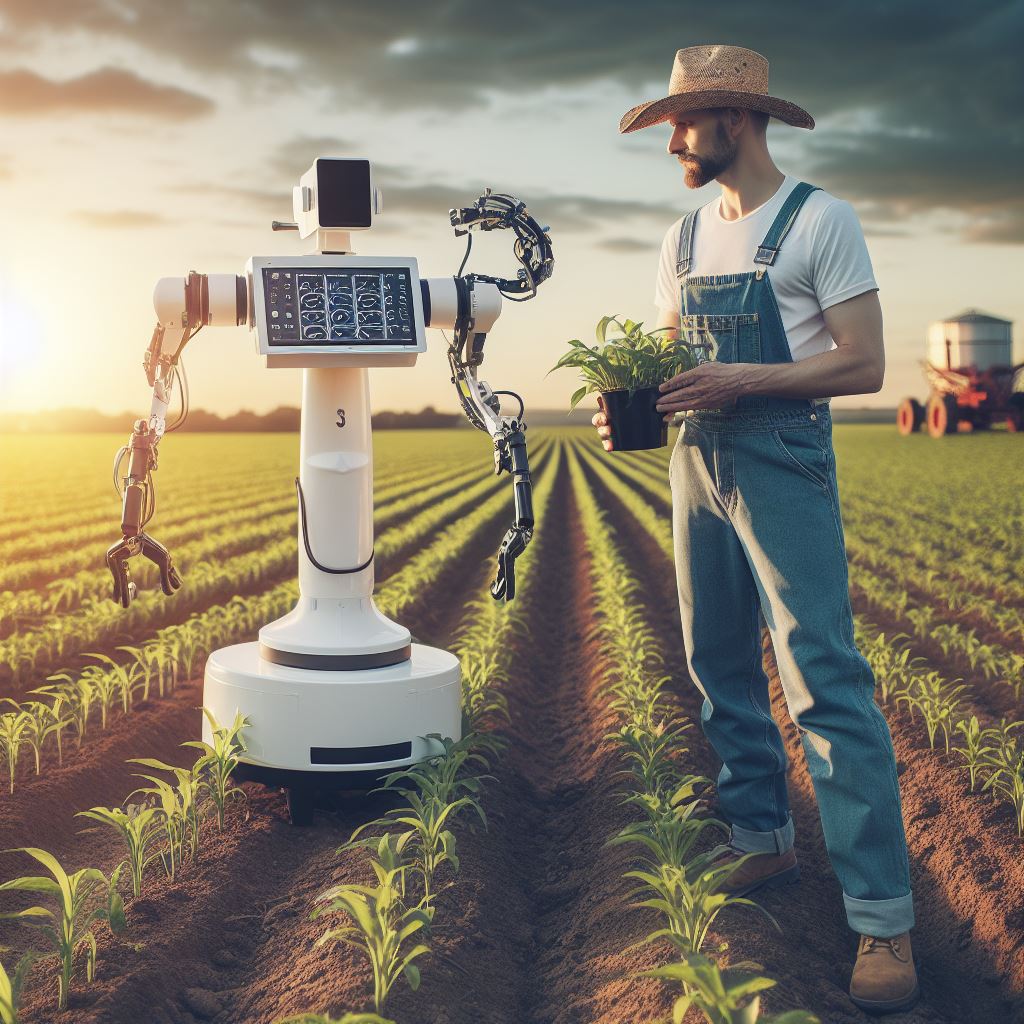Future of Farms: AI & Robotics in Agriculture
Last Updated on January 22, 2024
Introduction
Importance of agriculture in modern society
The importance of agriculture in modern society cannot be overstated.
It not only provides us with the food we eat but also supports numerous industries, such as textiles and pharmaceuticals.
As the global population continues to grow, the demand for agricultural products will increase exponentially.
However, the traditional methods of farming are facing challenges.
Climate change, labor shortages, and the need for more sustainable practices are becoming pressing issues.
This is where AI and robotics come into play.
Rapid advancements in AI and robotics
Recent advancements in AI and robotics technologies have opened up new opportunities for the agricultural industry.
With AI-powered systems and robots, farmers can optimize crop production, monitor plant health, and automate labor-intensive tasks.
This not only improves efficiency but also reduces costs and minimizes environmental impact.
Preview of the future of farms with AI and robotics
Imagine a future where drones and autonomous vehicles handle seeding, watering, and harvesting.
AI algorithms analyze soil and weather data to determine optimal planting times and fertilizer distribution.
Robots equipped with computer vision can identify and remove crop diseases, improving crop yields without the need for chemical treatments.
In the coming sections, we will delve into the various applications of AI and robotics in agriculture, exploring how they are revolutionizing farming practices and shaping the future of food production.
Impacts of AI in Agriculture
As technology advances, the integration of Artificial Intelligence (AI) and robotics in agriculture brings about significant and positive impacts.
These advancements revolutionize traditional farming practices, offering farmers efficient techniques and tools to improve crop yield, productivity, resource management, and pest/weed control.
Improved crop yield and productivity
Precision agriculture techniques using AI
Precision agriculture techniques utilizing AI play a crucial role in enhancing crop yield and productivity.
AI algorithms analyze various data sources, such as weather patterns, soil conditions, and crop health, allowing farmers to make informed decisions.
By precisely tailoring planting, irrigation, and harvesting practices, farmers can optimize crop production and minimize losses.
Automated monitoring and decision-making
Furthermore, automated monitoring and decision-making systems based on AI algorithms provide real-time insights into crop conditions.
These systems can monitor factors like nutrient levels, moisture content, and disease prevalence.
The continuous monitoring and analysis enable quick interventions, ensuring optimal crop growth and reducing risks of crop failure.
Efficient resource management
Agriculture heavily relies on essential resources like water and fertilizers, which need to be managed efficiently for sustainable farming.
AI contributes significantly to this aspect of agriculture.
Water usage optimization with AI algorithms
AI algorithms can optimize water usage by considering various factors such as soil moisture levels, weather forecasts, and crop growth stages.
By analyzing these data points, farmers can implement precise irrigation schedules and techniques, avoiding under/over-watering and minimizing water waste.
Reduced fertilizer usage through smart systems
Similarly, AI-powered smart systems help reduce fertilizer usage while maintaining crop productivity.
These systems analyze soil composition and crop nutrient requirements.
They provide recommendations on fertilizer type, quantity, and timing, ensuring that plants receive adequate nutrition without excessive use of fertilizers.
Enhanced pest and weed control
Pests and weeds pose significant challenges to farmers as they can cause substantial crop damage if not controlled effectively.
AI-powered drones for early pest detection
AI and robotics offer innovative solutions for early pest detection and precise control measures.
AI-powered drones equipped with high-resolution cameras enable early detection of pests and diseases.
These drones can fly over fields, capturing detailed images that AI algorithms can analyze to identify potential threats.
With quick and accurate identification, farmers can promptly implement targeted interventions, such as using specific pesticides or introducing biological controls, preventing further damage and reducing reliance on broad-spectrum chemicals.
Robotics for precision spraying and targeted weeding
In addition to pest control, robotics technology plays a crucial role in weed management.
Robots equipped with AI and computer vision systems can identify and differentiate between crops and weeds.
This enables targeted and precise weed spraying, minimizing herbicide usage and avoiding damage to the desired plants.
These robotic systems can navigate through fields autonomously, precisely and efficiently removing weeds, reducing labor-intensive manual labor.
Essentially, the adoption of AI and robotics in agriculture brings tremendous benefits to the industry.
Improved crop yield and productivity, efficient resource management, and enhanced pest and weed control are some of the positive impacts.
As technology continues to advance, farmers can expect further optimization and advancements in farming practices, paving the way for a more sustainable and productive future.
Read: Robotics in Agriculture: A 2024 Overview
Role of Robotics in Agriculture
With the rapid advancement of technology, the agricultural industry is undergoing a transformation.
The integration of artificial intelligence (AI) and robotics is revolutionizing the way we farm.
By automating labor-intensive tasks, improving operational efficiency, and providing benefits for livestock farming, robotics is reshaping the future of agriculture.
Automation of labor-intensive tasks
One of the significant contributions of robotics in agriculture is the automation of labor-intensive tasks.
Traditional farming practices often rely on manual labor, consuming valuable time and resources.
However, with the implementation of robotic systems, these tasks can be completed efficiently and with minimal human intervention.
Robotic harvesters and pickers
Robotic harvesters and pickers are prime examples of how automation can revolutionize crop collection.
These machines are designed to identify ripe fruits or vegetables and carefully harvest them without causing any damage.
With the ability to work day and night, these robotic systems can significantly increase farm productivity and reduce dependency on human labor.
Development of autonomous seeding and transplanting systems
Another area where robotics has excelled is the development of autonomous seeding and transplanting systems.
These robotic machines are capable of precisely planting seeds or seedlings in designated locations, ensuring optimal distribution and consistent growth.
By eliminating the need for manual labor, farmers can save time and streamline the planting process, ultimately leading to increased yields.
Improve operational efficiency
In addition to automating labor-intensive tasks, robotics plays a crucial role in enhancing operational efficiency on farms.
By utilizing robotic technology, farmers can improve various aspects of their daily operations, leading to increased productivity and reduced costs.
Robotic milkers and feeding systems
Robotic milkers and feeding systems are transforming the dairy industry.
These automated machines ensure efficient milking processes by accurately identifying and attaching milking cups to cows, reducing the need for human intervention.
Additionally, they can monitor milk output and individual cow health, allowing for early detection of any issues.
By optimizing the milking process, farmers can increase milk production and reduce labor costs.
Self-driving tractors
Self-driving tractors are another remarkable innovation in agricultural robotics.
These autonomous machines can navigate fields and perform tasks such as plowing, seeding, and crop maintenance with high precision.
By automating these tasks, farmers can save time, optimize resource allocation, and achieve higher levels of efficiency in field management.
Self-driving tractors also offer real-time data collection capabilities, allowing farmers to make informed decisions based on accurate field information.
Benefits for livestock farming
Livestock farming also greatly benefits from the integration of robotics.
The advanced capabilities of robotic systems provide improved monitoring, better animal care, and increased efficiency in the management of livestock.
Robotic monitoring systems
Robotic monitoring systems enable continuous tracking of livestock health and behavior.
These systems can detect early signs of diseases or distress, allowing farmers to intervene promptly and provide appropriate care.
Real-time monitoring of animals also helps optimize breeding cycles, improve reproduction rates, and ensure overall herd well-being.
Automated feeding and waste management systems
Automated feeding and waste management systems are valuable additions to livestock farming.
These systems ensure animals receive highly accurate and consistent feed portions, promoting healthier growth and reducing waste.
The automation of waste management processes also helps maintain a cleaner and more hygienic environment for the livestock, preventing the spread of diseases and reducing the overall ecological impact.
In general, robotics is playing a pivotal role in shaping the future of agriculture.
By automating labor-intensive tasks, improving operational efficiency, and providing various benefits for livestock farming, robotics is revolutionizing the industry.
Embracing these technological advancements will not only increase productivity but also contribute to sustainable and efficient agricultural practices.
Read: Farm Tech: AI for Sustainable Growth

Challenges and Concerns
Implementing AI and robotics on farms undoubtedly brings numerous benefits, but it also raises several challenges and concerns.
In this section, we will explore some of the primary obstacles associated with the future of farms incorporating AI and robotics.
Cost of implementing AI and robotics on farms
Initial investment and maintenance expenses
The integration of AI and robotics into farming operations requires a significant upfront investment.
From purchasing the necessary equipment and machinery to setting up infrastructure, the initial costs can be substantial.
Furthermore, ongoing maintenance expenses, including repairs and upgrades, need to be considered, adding to the overall costs.
Affordability for small-scale farmers
While larger farms may have the financial resources to invest in AI and robotics, small-scale farmers may face affordability challenges.
The high costs involved make it difficult for them to adopt these technologies, potentially creating disparities in the industry between large and small farms.
Job displacement and training requirements
Potential decrease in agricultural job opportunities
The implementation of AI and robotics in agriculture may lead to a reduction in the number of available jobs.
Tasks that were previously performed by human workers can now be automated, resulting in potential job displacement.
This can have significant social and economic implications for communities dependent on agricultural employment.
Need for specialized training in AI and robotics
Operating and maintaining AI and robotic systems require specialized knowledge and skills.
Farm workers will need to undergo training to adapt to the changing technological landscape.
However, access to such training programs may be limited, especially in rural areas, posing a challenge to the workforce’s upskilling.
Ethical considerations
Potential ethical Dilemmas with autonomous decision-making
As AI and robotics become more advanced, there is a growing concern about the ethical implications of autonomous decision-making.
Machines may face complex choices in agricultural practices, such as pest control and harvesting, raising questions about accountability and the potential consequences of algorithmic decision-making.
Ensuring AI and robotics align with sustainable practices
It is essential to ensure that AI and robotics in agriculture align with sustainable practices.
The technologies should contribute positively to environmental stewardship, minimizing resource consumption, and reducing harmful impacts.
Striking a balance between efficiency and sustainability will be crucial for the future of farming.
In essence, while AI and robotics offer immense potential to transform agriculture, there are challenges that need to be addressed.
The cost of implementation and affordability for small-scale farmers, job displacement concerns, training requirements, and ethical considerations must be taken into account.
By proactively addressing these challenges, we can strive for a future where AI and robotics in agriculture create a more sustainable and equitable farming industry.
Read: Agri Robots: The Field’s New Friends
Future Possibilities
In addition to AI and robotics, the future of farming will involve the integration of these technologies with others, opening up endless possibilities for agriculture.
Integration of AI and robotics with other technologies
- The Internet of Things (IoT): The Internet of Things (IoT) can play a crucial role in farming by connecting different devices and systems on the farm. Through IoT connections, farmers can monitor, control, and automate various farming processes and machinery. For example, smart sensors can collect data on soil moisture levels or crop growth, which can then be analyzed to determine optimal irrigation or fertilizer usage.
- Big data analytics: Big data analytics can revolutionize farming by enabling predictive farming. By analyzing vast amounts of data, such as weather patterns, historical crop yields, or market demand, farmers can make informed decisions to maximize productivity and minimize risks. Predictive analytics can help farmers optimize planting times, predict disease outbreaks, or adjust crop varieties based on market trends.
Adoption challenges and solutions
- Cost of implementing these technologies: Despite the potential benefits, the widespread adoption of AI and robotics in agriculture presents challenges. One major hurdle is the cost of implementing these technologies. However, governments can incentivize farmers to embrace new technologies by providing financial support or tax benefits. For instance, subsidies can be offered for the purchase of AI-powered machinery or equipment.
- Collaboration: Collaboration is another key solution for overcoming adoption challenges. Tech companies can work hand in hand with agricultural organizations to develop customized solutions tailored to farmers’ needs. By understanding the unique requirements and challenges faced by farmers, tech companies can design user-friendly and affordable technologies that integrate seamlessly into existing farming systems.
Potential benefits for global food security
- Increased crop production to meet growing demand: As the global population continues to grow, ensuring food security becomes increasingly critical. AI and robotics have the potential to significantly increase crop production. By optimizing farming processes, such as precision planting, automated harvesting, or targeted pest control, AI-powered machinery can enhance productivity and yield levels.
- Improved resilience against climate change: Furthermore, AI and robotics can help enhance the resilience of farming systems against climate change. These technologies can monitor and analyze environmental conditions, allowing farmers to make timely adjustments to cultivation methods. By optimizing water and fertilizer usage, farmers can reduce their environmental impact while still maintaining high crop yields in the face of changing climatic conditions.
In a nutshell, the future of farms lies in the integration of AI and robotics with other technologies.
This integration opens up a world of possibilities for agriculture, from improved decision-making through big data analytics to the automation of farming processes through IoT connections.
Despite adoption challenges, government incentives and collaboration between tech companies and agricultural organizations can drive progress.
Ultimately, the potential benefits for global food security, such as increased crop production and improved resilience against climate change, make the incorporation of AI and robotics in agriculture a promising avenue for the future.
Read: Smart Farming: AI’s Growing Impact
Conclusion
AI and robotics will transform farming in the coming decades.
Automating tedious tasks like weed control frees up time for farmers to focus on maximizing yields.
Meanwhile, data-driven insights on weather, soil, and crops help inform real-time management decisions.
Farms of the future will likely see fleets of autonomous tractors, drones surveying fields, and robots harvesting ripe produce.
With machine learning algorithms, this technology will only become more intelligent and responsive.
An integrated approach to AI and robotics can make agriculture more profitable, efficient, and sustainable.
While the upfront costs may seem high, the long-term benefits will likely outweigh any initial hesitation.
The key is embracing innovation rather than resisting it.
By supplementing human knowledge rather than replacing it, agricultural technology can help farmers thrive for generations.
The future of farming may feel uncertain, but it holds incredible potential.
With care, creativity and community, growers can craft a vision of agriculture where both people and the planet prosper through sustainable innovation.
The time to start investing in a brighter tomorrow is now.


